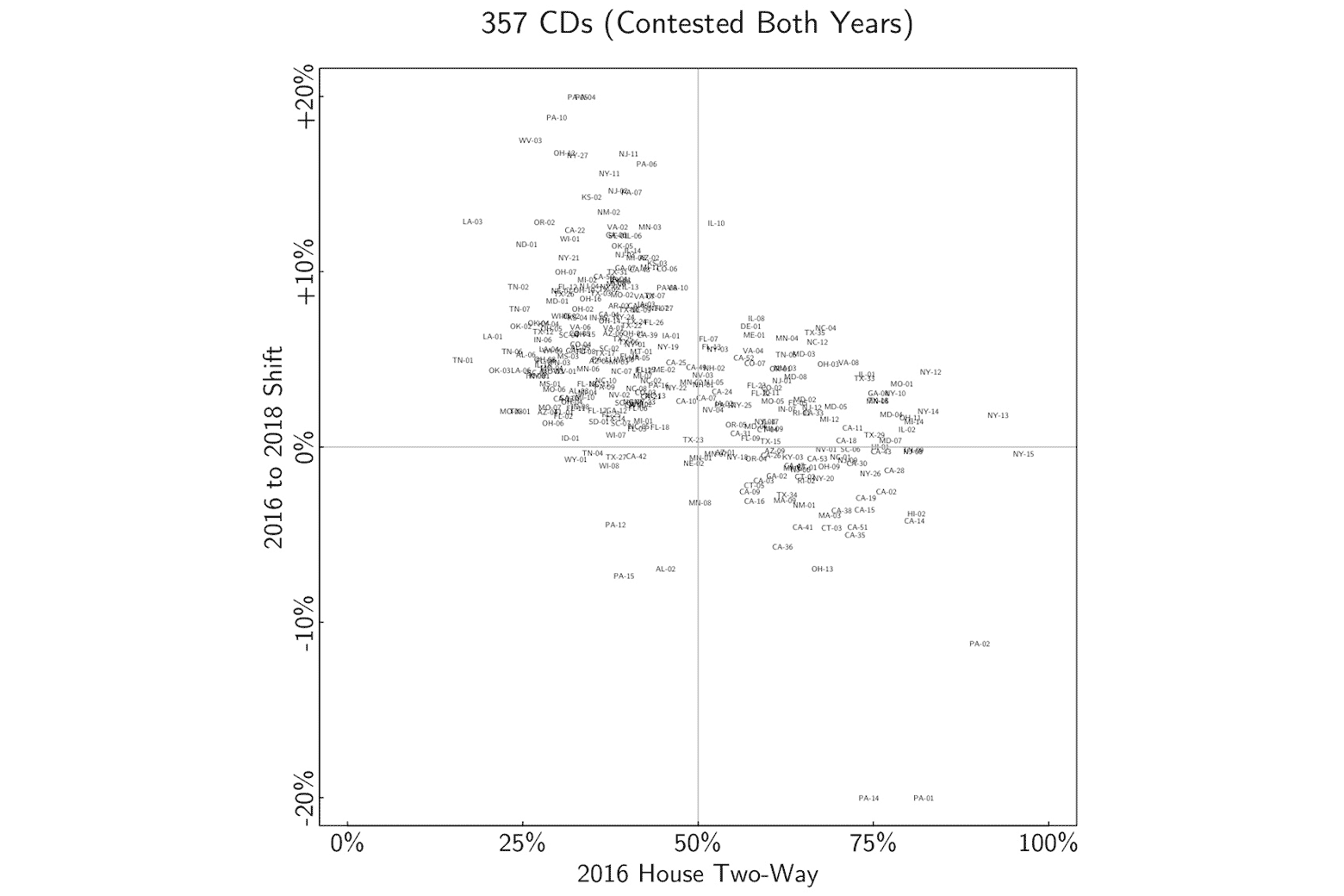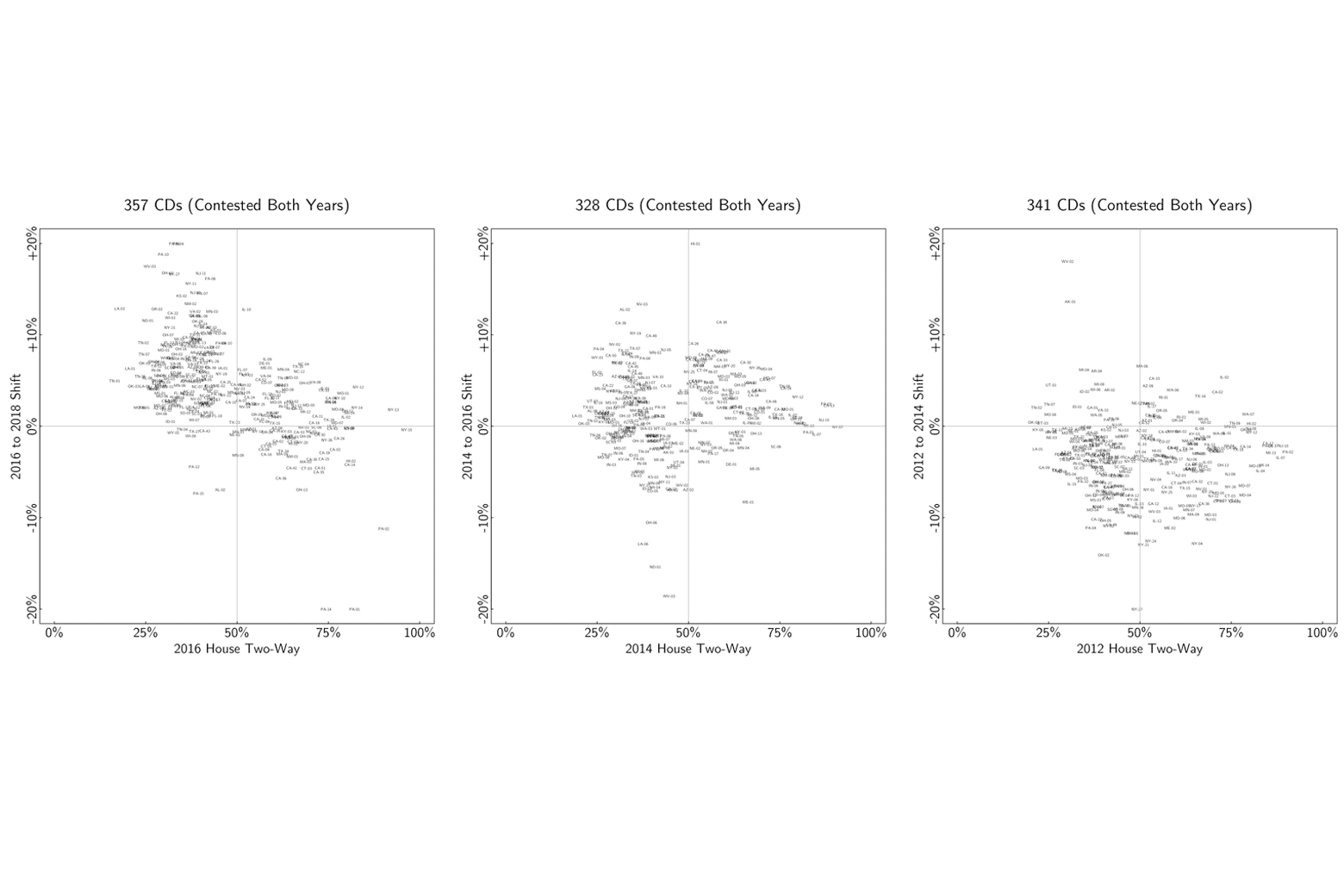Why the 2018 Midterms May Have Been Bluer Than You Think
The wave looks like it was real, even in places where the candidates didn’t win.

Andrew Gelman | November 12, 2018
What can we really learn from what happened in the 2018 midterm elections? When we talk about election results, we’re always discussing them on three levels: their direct political consequences, their implications for future politics, and what they allow us to infer about public opinion.
At the national level, what happened is what we expected to happen two weeks ago, two months ago, and two years ago: The Democrats bounced back. Their average district vote for the House of Representatives increased by enough to give them clear control of the chamber, even in the face of geography difficulties and partisan districting.
This was party balancing, which I wrote about a few months ago: At the time of the election, the Republicans controlled the executive branch, both houses of Congress, and the judiciary, so it made sense that swing voters were going to swing toward the Democrats. Ironically, one reason the Democrats did not regain the Senate in 2018 is … party balancing in 2016! Most people thought Hillary Clinton would win the presidency, so lots of people voted Republican for Congress to balance that.
The swing in votes toward the Democrats was large, particularly in the context of our current state of political polarization. As Nate Cohn wrote, the change in seats was impressive, given that there weren’t very many swing districts for the Democrats to aim for. Meanwhile, as expected, the Senate remained in Republican control. Some close races went 51-49 rather than 49-51, which doesn’t tell us much about public opinion but is politically consequential.
The next question is geographic—where did the shift happen? Nationally, voters swung toward the Democrats. I was curious where this happened, so I did some Googling and found this map by Josh Holder, Cath Levett, Daniel Levitt, and Peter Andringa at the Guardian. The map omits districts that were uncontested in one election or the other, so I suspect it understates the swing, but it gives the general idea—the swing was the strongest throughout the Midwest, and even extended south to Florida and Texas.
Here’s another way to look at the swings. Yair Ghitza, a senior scientist at the data firm Catalist, made a graph plotting the vote swing from 2016 to 2018, for each election contested in both years, vs. the Democratic share of the two-party vote in 2016.

The result was pretty stunning. Here’s the key takeaway: The Democrats’ biggest gains in 2018 were in districts where the Republicans were dominant in 2016—that’s the story for all the districts that show up in the top left quadrant of this chart.
In fact, if you look at the graph carefully (and you also remember that we’re excluding uncontested elections, so we’re missing part of the story), you see the following:
- In strong Republican districts (Dems receiving less than 40 percent of the vote in 2016), Democrats gained almost everywhere, with an average gain of something like 8 percentage points.
- In swing districts (Dems receiving 40-60 percent of the vote in 2016), Democrats improved, but only by about 4 percentage points on average. A 4-percent swing in the vote is a lot, actually! It’s just not 8 percent.
- In districts where Ds were already dominating, the results were, on average, similar to what happened in 2016.
I don’t know how much this was a national strategy and how much it just happened, but let me point out two things:
1. For the goal of winning the election, it would have been to the Democrats’ advantage to concentrate their gains in the zone where they’d received between 40 and 55 percent of the vote in the previous election. Conversely, these are the places where the Republicans would’ve wanted to focus their efforts too.
2. Speaking more generally, the Democrats have had a problem, both at the congressional and presidential levels, of “wasted votes”: winning certain districts with huge majorities and losing a lot of the closer districts. Thus, part of Democratic strategy has been to broaden their geographic base. The above scatterplot suggests that the 2018 election was a step in the right direction for them in this regard.
When Yair sent me that plot, I had a statistical question: Could it be “regression to the mean”—did this just show things going back to normal? We would expect, absent any election-specific information, that the Democrats would improve in districts where they’d done poorly, and they’d decline in districts where they’d done well. So maybe I’ve just been overinterpreting a pattern that tells us nothing interesting at all?
To address this possible problem, Yair made two more graphs, repeating the above scatterplot, but showing the 2014-to-2016 shift vs. the 2014 results, and the 2012-to-2014 shift vs. the 2012 results. Here’s what he found:

So the answer is: No, it’s not regression to the mean, and it’s not a statistical artifact. The shift from 2016 to 2018—the Democrats gaining strength in Republican strongholds—is real. And it can have implications for statewide and presidential elections as well. This is also consistent with results we saw in various special elections during the past two years.
That means the current narrative is wrong. As Yair puts it:
Current narrative: Dems did better in suburban/urban, Reps did better in rural, continuing trend from 2012-2016. I am seeing the opposite.
This isn’t increasing polarization/sorting. This also isn’t mean-reversion. D areas stayed D, R areas jumped ship to a large degree. A lot of these are the rural areas that went the other way from 2012-2016.
Not just in [Congressional District] races, also in Govenor and Senate races …
Massive, 20+ point shift in margin in Trump counties. Remember this is with really high turnout. … This offsets the huge shift from 2012-2016, often in the famous “Obama-Trump” counties.
Yair adds:
The reason people are missing this story right now: focusing on who won/lost means they’re looking at places that went from just below 50 to just above 50. Obviously that’s more important for who actually governs. But this is the big public opinion shift.
I suspect that part of this was the result of deliberate strategy from both parties. On one side, the Democrats knew they had a problem in big swathes of the country and they made a special effort to run strong campaigns everywhere: Part of this was good sense given their good showing in special elections, and part of it was an investment in their future, to lay out a strong Democratic brand in areas that where they’ll need to be competitive in future statewide and presidential elections. On the other side, the Republicans had their backs to the wall and so they focused their effort on the seats they needed to hold if they had a chance of maintaining their House majority.
From that standpoint, the swings above do not completely represent natural public opinion swings from national campaigns. But they are meaningful: They’re real votes, and they’re in places where the Democrats need to gain votes in the future. As Yair wrote me, “Before the election, a scenario where the Democrats gained ground in urban areas and lost some in rural could have seemed perfectly plausible. Indeed that’s still the story being written to a large extent. I also do wonder whether familiarity with these statistical concepts (reversion to the mean, ceiling effects) makes smart people underestimate what happened on the ground—many Republicans in Republican areas voting for a Democrat for the first time in a long time.”
There are also some policy implications: If Democratic challengers are more competitive in previously solid Republican districts, enough so that the Republican occupants of these seats are more afraid of losing centrist votes in future general elections than losing votes on the right in future primaries, this could motivate these Republicans to vote more moderately in Congress. We’ll just have to wait and see.

